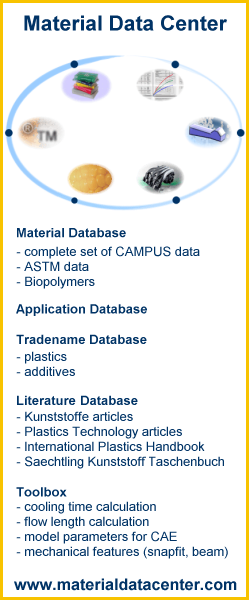
Material datasheets available free. Online registration at: www.materialdatacenter.com
Hydrocerol - Blowing agents, Nucleating agents - Clariant International Ltd
Material Data Center is a leading international information system for the plastics industry. Material Data Center offers a comprehensive plastics database, calculation tools, CAE interfaces, a literature database and an application database. For more information about Material Data Center visit www.materialdatacenter.com.
A search for "Hydrocerol" in Material Data Center leads to the following information:
|
|
Material Data Center offers information about the following products with the requested tradename. To view a datasheet, please click on the relevant product.
...tion speed are also varied. The materials used are an epoxy resin molding compound (type: Epoxidur EP 3582; manufacturer: Raschig GmbH, Ludwigshafen, Germany) and an endothermic chemical blowing agent (BIH, type: Hydrocerol BIH; manufacturer: Clariant Plastics & Coatings (Deutschland) GmbH, Lahnstein, Germany). Hollow Glass Spheres as an Alternative An alternative approach to density reduction is the use of hollow glass spheres (HGS). These have a lower density than the molding compound and thus...
Kunststoffe international, 2005-11-21, Adhesives: What Do Adhesives Accomplish in Practical Processes?
Composite Materials What Do Adhesives Accomplish in Practical Processes? Adhesives. Thermoplastic natural fibre-reinforced composites are gaining increasing market share. A frequently discussed problem is the adhesion between the natural fibres and the polyolefin matrix. A great deal of study has been carried out on the basic principles, but what an adhesive is actually able to do in practice in the various composite processes is barely known. Natural fibres in composites are nothing new. The a...
Kunststoffe international, 2005-11-21, Influencing Product Properties: Additive Masterbatches for Foam Film
...n solution at the molecular level in the melt. The actual foaming takes place only after the melt exits from the die. This is shown schematically in Fig. 1. Endothermic blowing agents have become established primarily in the packaging sector (grade: Hydrocerol, manufacturer: Clariant). Sodium bicarbonate and citric acid derivatives as well as mixtures thereof in various ratios are encountered largely wherever the final products (e.g., dinner trays) come into contact with food. Exothermic blowin...
Kunststoffe international, 2005-11-21, Thin-walled Components
...ing agent concentrations (Brabender single-screw extruder 19mm, L/D25) was tested. In all the tests, the screw speed was 601/min. Fig.1 shows the pressure and screw speed: even at a low concentration of 0.3% endothermal blowing agent system (grade: Hydrocerol, manufacturer: Clariant), a pressure loss of 10 to 15bar (about 20%) was measured. Nucleation and Dispersion The following parameters, which can be optimised by suitable blowing agent systems, are crucial to the success of the foaming pro...
Kunststoffe international, 2008-11-20, Physical Foaming with Standard Extruders
...egment was examined. Based on the results shown in Figure 3, the proportion of blowing agent was varied between 0.4 and 1% by weight. Die pressure was adjusted to values of 20, 30, and 40 bar. A talcum masterbatch (grade: Hydrocerol CT692; manufacturer: Clariant Masterbatches GmbH, Lahnstein, Germany) was used as nucleating agent, and was added in amounts of 2.5 to 3.5 % by weight. As shown in the results of the foam structure analysis (Fig. 4), average cell diameter and the cel...
Kunststoffe international, 2010-09-24, Stable PET Foaming
...apparatus engineering, construction), profile and pipe extrusion (picture frames, seals, foam core pipes). If the foamed films are to be used for food packagings, the blowing agent must have food authorization. Most of the endothermal Hydrocerol grades by Clariant do so. The Hydrocerol PEX series was specially designed for extrusion application. The foam structures generated are very finecelled and cause good mechanical strengths in thermoformed articles. The surfaces are smooth and can be print...
Kunststoffe international, 2015-09-18, Lighter and Economical
... and with good mechanical properties. These advantages accrue from the partial replacement of the talc content in PP compounds with Milliken’s Hyperform HPR-803i reinforcing fibers (Fig. 1) and from the additional use of Clariant’s blowing agent Hydrocerol masterbatch to expansion-mold the part by the core-back process.Reinforced FoamingHydrocerol masterbatches are endothermic blowing agents used for reducing the weight of processed plastics, for example, for injection molding applications. Due ...
Kunststoffe international, 2018-08-14, CO2 Foaming Made Easy
...lt. The plastic granules and the additives (e. g. nucleating agents) were fed into the extruder with a gravimetric metering device from Motan Colortronic GmbH, Friedrichsdorf, Germany. The nucleating agent used was a passive talcum masterbatch (Hydrocerol Nuc 5510, Clariant Plastics & Coatings (Deutschland) GmbH, Ahrensburg, Germany). An instrumented inline rheometer die with glass inserts and an annular sheet die were used as foam extrusion dies.Experimental Procedure Two different extrusion di...
Additional information about this tradename, like producer contact address, etc. can be found at www.materialdatacenter.com. For access to this extra information a registration is requested. Free online registration is available.
Note: the information in Material Data Center was collected with maximum care, based on information from material producers. They are subject to short term changes at the market. There is no warranty for the correctness of this information. In no way this information can be seen as a legal advice, whether certain tradenames are protected or not.
